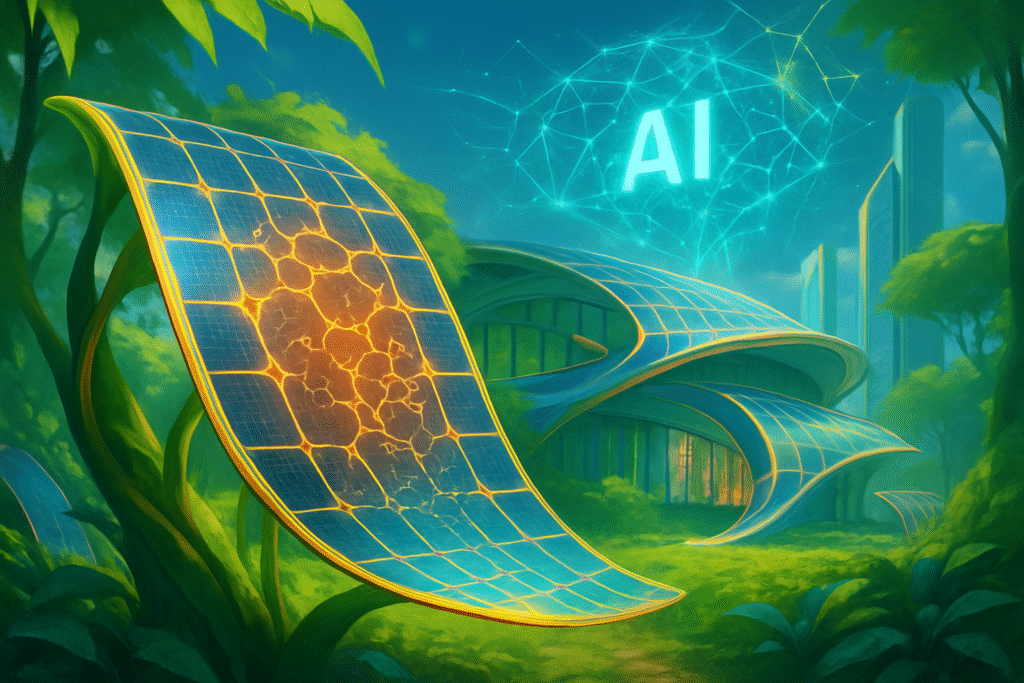
Cambridge, UK – October 1, 2025 – A groundbreaking discovery by researchers at the University of Cambridge has sent ripples through the scientific community, potentially revolutionizing solar energy harvesting and offering a critical pathway towards truly sustainable artificial intelligence solutions. Scientists have uncovered Mott-Hubbard physics, a quantum mechanical phenomenon previously observed only in inorganic metal oxides, within a single organic radical semiconductor molecule. This breakthrough promises to simplify solar panel design, making them lighter, more cost-effective, and entirely organic.
The implications of this discovery, published today, are profound. By demonstrating the potential for efficient charge generation within a single organic material, the research opens the door to a new generation of solar cells that could power everything from smart cities to vast AI data centers with unprecedented environmental efficiency. This fundamental shift could significantly reduce the colossal energy footprint of modern AI, transforming how we develop and deploy intelligent systems.
Unpacking the Quantum Leap in Organic Semiconductors
The core of this monumental achievement lies in the organic radical semiconductor molecule, P3TTM. Professors Hugo Bronstein and Sir Richard Friend, leading the interdisciplinary team from Cambridge's Yusuf Hamied Department of Chemistry and the Department of Physics, observed Mott-Hubbard physics at play within P3TTM. This phenomenon, which describes how electron-electron interactions can localize electrons and create insulating states in materials that would otherwise be metallic, has been a cornerstone of understanding inorganic semiconductors. Its discovery in a single organic molecule challenges over a century of established physics, suggesting that charge generation and transport can be achieved with far simpler material architectures than previously imagined.
Historically, organic solar cells have relied on blends of donor and acceptor materials to facilitate charge separation, a complex process that often limits efficiency and stability. The revelation that a single organic material can exhibit Mott-Hubbard physics implies that these complex blends might no longer be necessary. This simplification could drastically reduce manufacturing complexity and cost, while potentially boosting the intrinsic efficiency and longevity of organic photovoltaic (OPV) devices. Unlike traditional silicon-based solar cells, which are rigid and energy-intensive to produce, these organic counterparts are inherently flexible, lightweight, and can be fabricated using solution-based processes, akin to printing or painting.
This breakthrough is further amplified by concurrent advancements in AI-driven materials science. For instance, an interdisciplinary team at the University of Illinois Urbana-Champaign, in collaboration with Professor Alán Aspuru-Guzik from the University of Toronto, recently used AI and automated chemical synthesis to identify principles for improving the photostability of light-harvesting molecules, making them four times more stable. Similarly, researchers at the Karlsruhe Institute of Technology (KIT) and the Helmholtz Institute Erlangen-Nuremberg for Renewable Energies (HI ERN) leveraged AI to rapidly discover new organic molecules for perovskite solar cells, achieving efficiencies in weeks that would traditionally take years. These parallel developments underscore a broader trend where AI is not just optimizing existing technologies but fundamentally accelerating the discovery of new materials and physical principles. Initial reactions from the AI research community and industry experts are overwhelmingly positive, highlighting the potential for a symbiotic relationship where advanced materials power AI, and AI accelerates materials discovery.
Reshaping the Landscape for Tech Giants and AI Innovators
This organic molecule breakthrough stands to significantly benefit a wide array of companies across the tech and energy sectors. Traditional solar manufacturers may face disruption as the advantages of flexible, lightweight, and potentially ultra-low-cost organic solar cells become more apparent. Companies specializing in flexible electronics, wearable technology, and the Internet of Things (IoT) are poised for substantial gains, as the new organic materials offer a self-sustaining power source that can be seamlessly integrated into diverse form factors.
Major AI labs and tech companies, particularly those grappling with the escalating energy demands of their large language models and complex AI infrastructures, stand to gain immensely. Companies like Google (Alphabet Inc.), Amazon, and Microsoft, which operate vast data centers, could leverage these advancements to significantly reduce their carbon footprint and achieve ambitious sustainability goals. The ability to generate power more efficiently and locally could lead to more resilient and distributed AI operations. Startups focused on edge AI and sustainable computing will find fertile ground, as the new organic solar cells can power remote sensors, autonomous devices, and localized AI processing units without relying on traditional grid infrastructure.
The competitive implications are clear: early adopters of this technology, both in materials science and AI application, will gain a strategic advantage. Companies investing in the research and development of these organic semiconductors, or those integrating them into their product lines, will lead the charge towards a greener, more decentralized energy future. This development could disrupt existing energy product markets by offering a more versatile and environmentally friendly alternative, shifting market positioning towards innovation in materials and sustainable integration.
A New Pillar in the AI Sustainability Movement
This breakthrough in organic semiconductors fits perfectly into the broader AI landscape's urgent drive towards sustainability. As AI models grow in complexity and computational power, their energy consumption has become a significant concern. This discovery offers a tangible path to mitigating AI's environmental impact, allowing for the deployment of powerful AI systems with a reduced carbon footprint. It represents a crucial step in making AI not just intelligent, but also inherently green.
The impacts are far-reaching: from powering vast data centers with renewable energy to enabling self-sufficient edge AI devices in remote locations. It could democratize access to AI by reducing energy barriers, fostering innovation in underserved areas. Potential concerns, however, include the scalability of manufacturing these novel organic materials and ensuring their long-term stability and efficiency in diverse real-world conditions, though recent AI-enhanced photostability research addresses some of these. This milestone can be compared to the early breakthroughs in silicon transistor technology, which laid the foundation for modern computing; this organic molecule discovery could do the same for sustainable energy and, by extension, sustainable AI.
This development highlights a critical trend: the convergence of disparate scientific fields. AI is not just a consumer of energy but a powerful tool accelerating scientific discovery, including in materials science. This symbiotic relationship is key to tackling some of humanity's most pressing challenges, from climate change to resource scarcity. The ethical implications of AI's energy consumption are increasingly under scrutiny, and breakthroughs like this offer a proactive solution, aligning technological advancement with environmental responsibility.
The Horizon: From Lab to Global Impact
In the near term, experts predict a rapid acceleration in the development of single-material organic solar cells, moving from laboratory demonstrations to pilot-scale production. The immediate focus will be on optimizing the efficiency and stability of P3TTM-like molecules and exploring other organic systems that exhibit similar quantum phenomena. We can expect to see early applications in niche markets such as flexible displays, smart textiles, and advanced packaging, where the lightweight and conformable nature of these solar cells offers unique advantages.
Longer-term, the potential applications are vast and transformative. Imagine buildings with fully transparent, energy-generating windows, or entire urban landscapes seamlessly integrated with power-producing surfaces. Self-powered IoT networks could proliferate, enabling unprecedented levels of environmental monitoring, smart infrastructure, and precision agriculture. The vision of truly sustainable AI solutions, powered by ubiquitous, eco-friendly energy sources, moves closer to reality. Challenges remain, including scaling up production, further improving power conversion efficiencies to rival silicon in all contexts, and ensuring robust performance over decades. However, the integration of AI in materials discovery and optimization is expected to significantly shorten the development cycle.
Experts predict that this breakthrough marks the beginning of a new era in energy science, where organic materials will play an increasingly central role. The ability to engineer energy-harvesting properties at the molecular level, guided by AI, will unlock capabilities previously thought impossible. What happens next is a race to translate fundamental physics into practical, scalable solutions that can power the next generation of technology, especially the burgeoning field of artificial intelligence.
A Sustainable Future Powered by Organic Innovation
The discovery of Mott-Hubbard physics in an organic semiconductor molecule is not just a scientific curiosity; it is a pivotal moment in the quest for sustainable energy and responsible AI development. By offering a path to simpler, more efficient, and environmentally friendly solar energy harvesting, this breakthrough promises to reshape the energy landscape and significantly reduce the carbon footprint of the rapidly expanding AI industry.
The key takeaways are clear: organic molecules are no longer just a niche alternative but a frontline contender in renewable energy. The convergence of advanced materials science and artificial intelligence is creating a powerful synergy, accelerating discovery and overcoming long-standing challenges. This development's significance in AI history cannot be overstated, as it provides a tangible solution to one of the industry's most pressing ethical and practical concerns: its immense energy consumption.
In the coming weeks and months, watch for further announcements from research institutions and early-stage companies as they race to build upon this foundational discovery. The focus will be on translating this quantum leap into practical applications, validating performance, and scaling production. The future of sustainable AI is becoming increasingly reliant on breakthroughs in materials science, and this organic molecule revolution is lighting the way forward.
This content is intended for informational purposes only and represents analysis of current AI developments.
TokenRing AI delivers enterprise-grade solutions for multi-agent AI workflow orchestration, AI-powered development tools, and seamless remote collaboration platforms. For more information, visit https://www.tokenring.ai/.





